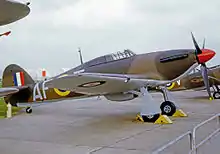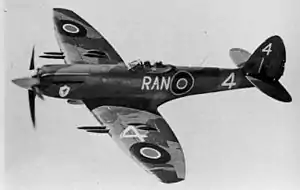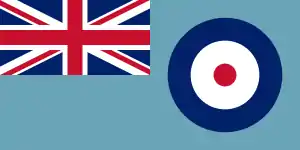No. 607 Squadron RAF
No. 607 (County of Durham) Squadron is an auxiliary squadron of the Royal Air Force. It was formed in 1930 as a bomber unit in the Auxiliary Air Force and changed in 1936 to the fighter role. It fought in that role during the Second World War in Europe and Asia. After the war, in 1946, the squadron reformed as a fighter unit. Awarded the title Royal Auxiliary Air Force by King George in 1947, 607 Sqn was disbanded with all the other flying units of the RAuxAF on 10 March 1957. It reformed on 5 January 2015, as a General Service Support Squadron (GSS).
| No. 607 (County of Durham) Squadron | |
|---|---|
| Active | 17 March 1930 – 31 July 1945 10 May 1946 – 10 March 1957 5 January 2015 - |
| Country | |
| Branch | |
| Part of | Royal Auxiliary Air Force |
| post 1951 aircraft insignia |  |
| Battle honours | France & Low Countries, 1939–40 Battle of Britain, 1940 Fortress Europe, 1941–42 Channel & North Sea, 1942 Arakan, 1942–44 Manipur, 1944 Burma, 1944–45 These seven honours are emblazoned on the squadron standard |
| Commanders | |
| Honorary Air Commodore | The Marquess of Londonderry (1932–1939) The Viscount Runciman of Doxford (1939–1957) Lady Charlotte Peel, The Countess Peel (2015-present) |
| Insignia | |
| Squadron Badge heraldry | A winged lion salient, the hind legs also winged[1] |
| Squadron Codes | LW (Mar 1939 – Sep 1939)[2] AF (Sep 1939 – May 1945)[3] RAN (Jun 1946 – 1949)[4] LA (1949 – Apr 1951)[5] |
History
Formation and early years
No. 607 Squadron was formed on 17 March 1930 at the then new airfield of RAF Usworth, County Durham[6] as a day bomber unit of the Auxiliary Air Force (AuxAF).[1] They became operational in the summer of 1933, having received their first aircraft in December 1932, flying Westland Wapitis. First commanding officer was Walter Leslie Runciman (later the 2nd Viscount Runciman of Doxford). In September 1936 the squadron was told that it was to re-role to a fighter squadron and was re-equipped with Hawker Demons. In the run up to WW2, 607 received Gloster Gladiators, which arrived in December 1938.
Second World War

Having achieved their first success downing a DO 18 flying boat in the North Sea and still equipped with Gladiators, the squadron was deployed to France as part of the Air Component of the British Expeditionary Force in November 1939. During the Battle of France, the squadron operated from various locations, including Saint-Inglevert. In March 1940, the squadron was re-equipped with Hawker Hurricanes, just in time to effectively operate against the modern Luftwaffe aircraft during the Blitzkrieg. Following the British withdrawal, the squadron returned to the United Kingdom and served throughout the Battle of Britain, firstly in the air defence of the North East of England then on the South coast with 11Gp. In October 1941, the Squadron moved to RAF Manston and remained there undertaking anti shipping operations and cross channel fighter sweeps until 1942. During this period, 607 became the first unit to operate the Hurricane in the fighter bomber role and using their "Hurri-bombers" destroyed or damaged several enemy support vessels during the German capital ships "Channel dash!" on 12 February 1942.
During 1942, the Squadron was transported to India. There, it joined No. 166 Wing RAF on 25 May 1942. In September 1943, the Squadron's Hurricanes were replaced with Supermarine Spitfires. This change in machine, made the squadron the first unit in South East Asia Command to operate such aircraft. It re-equipped with the Spitfire Mk.VIII in March 1944, and flew these in support of XIV Army, including the Imphal and Kohima actions, until disbanding on 19 August 1945 at Mingaladon in Burma.
607 were one of the last units to finish operations in this theatre.
Post-war
On 10 May 1946, No. 607 Squadron reformed at RAF Ouston as a day fighter squadron of the Royal Auxiliary Air Force. After flying Spitfire F.14 and F.22s for five years, it converted to De Havilland Vampires. These were flown until February 1957 when, along with all the other flying units of the RAuxAF, it was disbanded on 10 March 1957.[7]
Reformation
Re-formed 5 January 2015, the squadron is now a General Service Support Squadron (GSS)[8][9] and operates from RAF Leeming in North Yorkshire.[10] The squadron has an established strength of almost 120 staff and has won awards for its recruitment and retention abilities.[11]
Aircraft operated

| From | To | Aircraft | Version |
|---|---|---|---|
| December 1932 | January 1937 | Westland Wapiti | Mk.IIa |
| September 1936 | August 1939 | Hawker Demon | |
| December 1938 | May 1940 | Gloster Gladiator | Mks.I, II |
| March 1940 | September 1941 | Hawker Hurricane | Mk.I |
| June 1941 | November 1941 | Hawker Hurricane | Mk.IIa |
| July 1941 | March 1942 | Hawker Hurricane | Mk.IIb |
| June 1942 | February 1943 | Hawker Hurricane | Mk.IIc |
| February 1943 | September 1943 | Hawker Hurricane | Mk.IIb |
| September 1943 | March 1944 | Supermarine Spitfire | Mk.Vc |
| March 1944 | July 1945 | Supermarine Spitfire | Mk.VIII |
| November 1946 | March 1949 | Supermarine Spitfire | F.14 |
| January 1949 | June 1951 | Supermarine Spitfire | F.22 |
| March 1951 | March 1957 | De Havilland Vampire | FB.5 |
| April 1956 | February 1957 | De Havilland Vampire | FB.9 |
Squadron locations
| Airfields used by no. 607 Squadron RAF, data from[7][12][14][15] | ||
| From | To | Airfield |
|---|---|---|
| 17 March 1930 | 12 August 1939 | RAF Usworth, County Durham |
| 12 August 1939 | 24 August 1939 | RAF Abbotsinch, Renfrewshire, Scotland Annual Summer Camp only. |
| 24 August 1939 | 9 October 1939 | RAF Usworth, County Durham |
| 9 October 1939 | 14 November 1939 | RAF Acklington, Northumberland (Det. at RAF Drem, East Lothian, Scotland) |
| 14 November 1939 | 15 November 1939 | RAF Croydon, Surrey |
| 15 November 1939 | 13 December 1939 | Merville, France |
| 13 December 1939 | 12 April 1940 | Vitry-en-Artois, France (Dets. at Abbeville and Saint-Inglevert) |
| 12 April 1940 | 26 April 1940 | Abbeville, France |
| 26 April 1940 | 18 May 1940 | Vitry-en-Artois, France |
| 18 May 1940 | 22 May 1940 | Norrent-Fontes, France |
| 22 May 1940 | 4 June 1940 | RAF Croydon, Surrey |
| 4 June 1940 | 1 September 1940 | RAF Usworth, County Durham |
| 1 September 1940 | 10 October 1940 | RAF Tangmere, West Sussex |
| 10 October 1940 | 8 November 1940 | RAF Turnhouse, Fife, Scotland |
| 8 November 1940 | 12 December 1940 | RAF Drem, East Lothian, Scotland |
| 12 December 1940 | 16 January 1941 | RAF Usworth, County Durham |
| 16 January 1941 | 2 March 1941 | RAF Macmerry, East Lothian, Scotland |
| 2 March 1941 | 16 April 1941 | RAF Drem, East Lothian, Scotland |
| 16 April 1941 | 27 July 1941 | RAF Skitten, Caithness, Scotland |
| 27 July 1941 | 20 August 1941 | RAF Castletown, Caithness, Scotland |
| 20 August 1941 | 10 October 1941 | RAF Martlesham Heath, Suffolk |
| 10 October 1941 | 21 March 1942 | RAF Manston, Kent |
| 21 March 1942 | 25 May 1942 | en route to British India |
| 25 May 1942 | 23 August 1942 | RAF Alipore, Bengal |
| 23 August 1942 | 16 December 1942 | RAF Jessore, Bengal |
| 16 December 1942 | 23 January 1943 | RAF Feni, Bengal |
| 23 January 1943 | 2 April 1943 | RAF Chittagong, Bengal |
| 2 April 1943 | 1 October 1943 | RAF Alipore, Bengal |
| 1 October 1943 | 15 October 1943 | RAF Amarda Road, Bengal |
| 15 October 1943 | 29 November 1943 | RAF Alipore, Bengal |
| 29 November 1943 | 25 February 1944 | RAF Ramu, Bengal |
| 25 February 1944 | 21 March 1944 | RAF Nidania, Bengal |
| 21 March 1944 | 17 April 1944 | RAF Rumkhapalong ('Rumkha'), Bengal |
| 17 April 1944 | 27 April 1944 | RAF Wangjing, Manipur |
| 27 April 1944 | 6 July 1944 | RAF Imphal, Manipur |
| 6 July 1944 | 24 November 1944 | RAF Baigachi, Bengal |
| 24 November 1944 | 11 December 1944 | RAF Sapam, Manipur |
| 11 December 1944 | 16 January 1945 | RAF Tulihal, Manipur |
| 16 January 1945 | 5 April 1945 | RAF Tabingaung, Burma |
| 5 April 1945 | 19 April 1945 | RAF Dwehla, Burma |
| 19 April 1945 | 28 April 1945 | RAF Kwetnge, Burma |
| 28 April 1945 | 8 May 1945 | RAF Kalaywa, Burma |
| 8 May 1945 | 14 May 1945 | RAF Thedaw, Burma (Det. at 'Tennant' airfield, Burma) |
| 14 May 1945 | 19 August 1945 | RAF Mingaladon, Burma |
| 10 May 1946 | 10 March 1957 | RAF Ouston, County Durham |
| 16 July 1951 | 20 August 1951 | RAF Thornaby, North Yorkshire (detachment) |
| 20 August 1951 | 10 September 1951 | RAF Linton-on-Ouse, North Yorkshire (detachment) |
| 10 September 1951 | 10 October 1951 | RAF Acklington, Northumberland (detachment) |
| 10 October 1951 | 10 March 1957 | RAF Ouston, Northumberland |
| January 2015 | present | RAF Leeming, North Yorkshire |
Commanding officers
| From | To | Name |
|---|---|---|
| March 1930 | January 1939 | S/Ldr. W.L. Runciman |
| January 1939 | May 1940 | S/Ldr. L.E. Smith |
| May 1940 | May 1940 | S/Ldr G.M.Fidler Sqd OB May 1940 |
| 18 May 1940 | October 1940 | S/Ldr J.A. Vick Sqd OB May 1940 |
| October 1940 | March 1941 | S/Ldr. A.W. Vincent |
| March 1941 | November 1941 | S/Ldr. G.D. Craig |
| November 1941 | December 1941 | S/Ldr. H.C. Dawson |
| December 1941 | October 1942 | S/Ldr. N.J. Mowatt, DSO |
| October 1942 | March 1943 | S/Ldr. R.H. Holland, DFC |
| March 1943 | April 1943 | S/Ldr. N.J. Mowatt, DSO |
| April 1943 | March 1944 | S/Ldr. P.J.T. Stephenson, DFC |
| March 1944 | May 1945 | S/Ldr. G.G.A. Davies |
| May 1945 | June 1945 | S/Ldr. C.M. Humphreys |
| June 1945 | August 1945 | S/Ldr. C.O.J. Pegge, DFC |
| May 1946 | 1949 | S/Ldr. J.R. Kyall, DSO, OBE, DFC |
| 1949 | 1951 | S/Ldr. J.M. Bazin, DSO, DFC |
| 1951 | September 1953 | S/Ldr. A.B. Dunford, DFC |
| September 1953 | June 1956 | S/Ldr. J.A. Stephen |
| June 1956 | March 1957 | S/Ldr. G. Gray |
| January 2015 | January 2015 | Sqn Ldr A Hall |
| January 2015 | June 2018 | Wing commander A Dobson[10] |
| February 2019 | Wg Cdr M Shuttleworth |
References
Notes
- Halley 1988, p. 423.
- Bowyer & Rawlings 1979, p. 14.
- Bowyer & Rawlings 1979, p. 16.
- Bowyer & Rawlings 1979, p. 138.
- Bowyer & Rawlings 1979, p. 66.
- Moyes 1976, p. 277.
- Halley 1988, p. 424.
- "RAF - 607 (Country of Durham)Reserves". Archived from the original on 22 December 2015. Retrieved 18 December 2015.
- "RAF Reservist Squadron welcomes first recruits". Retrieved 18 December 2015.
- "Newly Reformed Sqn Remembers Its Past". www.raf.mod.uk. Retrieved 12 December 2017.
- Copeland, Alexa (21 July 2017). "Honour for Durham squadron following successful recruitment". The Northern Echo. ProQuest 1966200867.
- Rawlings 1978, p. 490.
- Rawlings 1978, pp. 490–491.
- Jefford 2001, p. 100.
- Jefford 2001, pp. 270–271.
- Rawlings 1978, p. 491.
- Hunt 1972, pp. 163–181.
Bibliography
- Bowyer, Michael J.F.; Rawlings, John D.R. (1979). Squadron Codes, 1937–56. Cambridge, UK: Patrick Stephens Ltd. ISBN 0-85059-364-6.
- Dixon, Robert (2004). A Gathering Of Eagles. London: PublishAmerica. ISBN 1-4137-3498-7.
- Dixon, Robert (2008). 607 Squadron: A Shade Of Blue. Stroud, Gloucestershire: The History Press. ISBN 978-0-7524-4531-1.
- Dixon, Robert (2011). Men Of The North A Few Of the Few. Wolf's Nick Publishing. ISBN 978-1-4664-4683-0.
- Flintham, Vic; Thomas, Andrew (2003). Combat Codes: A Full Explanation and Listing of British, Commonwealth and Allied Air Force Unit Codes since 1938. Shrewsbury, Shropshire, UK: Airlife Publishing Ltd. ISBN 1-84037-281-8.
- Halley, James J. (1980). The Squadrons of the Royal Air Force. Tonbridge, Kent, UK: Air-Britain (Historians) Ltd. ISBN 0-85130-083-9.
- Halley, James J. (1988). The Squadrons of the Royal Air Force & Commonwealth, 1918–1988. Tonbridge, Kent, UK: Air-Britain (Historians) Ltd. ISBN 0-85130-164-9.
- Hunt, Leslie (1972). Twenty-One Squadrons: The History of the Royal Auxiliary Air Force, 1925–1957. London: Garnstone Press. ISBN 0-85511-110-0.
- Jefford, C.G. (2001). RAF Squadrons, a Comprehensive record of the Movement and Equipment of all RAF Squadrons and their Antecedents since 1912 (2nd ed.). Shrewsbury, Shropshire, UK: Airlife Publishing Ltd. ISBN 1-85310-053-6.
- Moyes, Philip J.R. (1976). Bomber Squadrons of the RAF and their Aircraft. London: Macdonald and Jane's (Publishers) Ltd. ISBN 0-354-01027-1.
- Rawlings, John (1978) [1969]. Fighter Squadrons of the RAF and their Aircraft (Revised ed.). London: Macdonald and Jane's Publishers Ltd. ISBN 0-354-01028-X.
External links
| Wikimedia Commons has media related to No. 607 Squadron RAF. |
